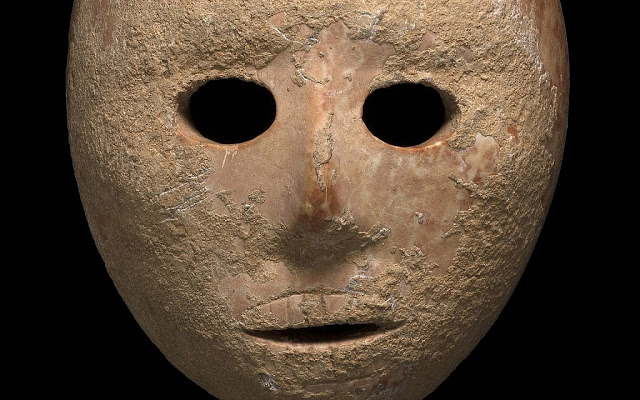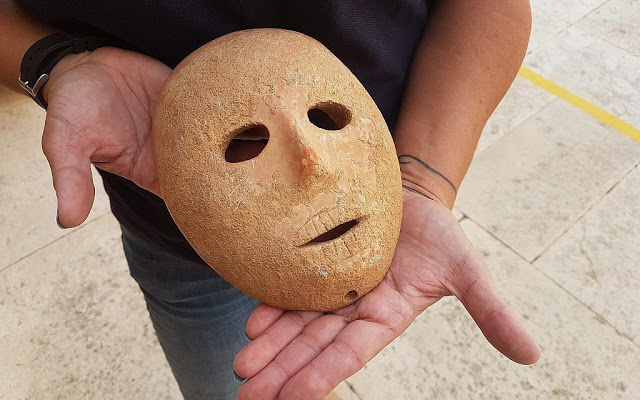The 9,000-year-old stone mask discovered in the southern Hebron Hills area of the West Bank in early 2018. (Credit: Antiquities Theft Prevention Unit/Israel Antiquities Authority) Israeli archeologist Ronit Lupu holds a rare stone mask dating to the Neolithic period which was found at the Pnei Hever region of southern Hebron mount, in this picture taken on November 28, 2018 Israeli archeologist Ronit Lupu holds a rare stone mask dating to the Neolithic period which was found at the Pnei Hever region of southern Hebron mount, in this picture taken on November 28, 2018 (Credit: Clara Amit/Israel Antiquities Authority)
Jérusalem--The Israel Antiquities Authority on Wednesday unveiled what it said was a rare 9,000-year-old stone mask linked to the beginnings of agricultural society.As reported by the Israel Antiquities Authority in an undated but recent release, circa November 2018:
The pink and yellow sandstone object was discovered in a field at the Jewish settlement of Pnei Hever, in the Israeli-occupied West Bank, said the IAA.
The artefact was handed in to authorities in early 2018.
"The mask is very naturalistic in the way it was made," said IAA archaeologist Ronit Lupu. "You can see the cheekbones, you can see a perfect nose."
"It's a rare mask," she told AFP. "The last one that we know was found 35 years ago. It's an amazing find, archaeologically speaking."
The West Bank is a Palestinian territory occupied by Israel in the 1967 Six-Day War.
Disputes over ownership of artefacts discovered there are just part of the long-running conflict with the Palestinians over the land.
The IAA placed the mask at a pivotal period in Neolithic culture.
"Stone masks are linked to the agricultural revolution," the authority said in a statement.
"The transition from an economy based on hunting and gathering to ancient agriculture and domestication of plants and animals was accompanied by a change in social structure and a sharp increase in ritual-religious activities."
Among such activities, it said, was ancestor worship.
"It was part of the ritual and retention of family heritage that was accepted at the time," the statement said.
"Stone masks, such as the one from Pnei Hever, are similar in size to the human face, which is why scholars tend to connect them with such worship."
A Rare Stone Slab c. 9,000 Years Old was Exposed that was used to Ignite Fire
Did you plan a bonfire for Lag B’Omer and forget your lighter at home? An exceptional find uncovered about a week ago demonstrates how to start a fire in the field without matches or a lighter. A rare stone slab that was apparently used by the country’s ancient inhabitants for lighting fire nine thousand years ago was exposed in an archaeological excavation of the Israel Antiquities Authority, in which students of the Hannaton pre-military preparatory program participated. The excavations are taking place at the junction of Highway 38 and Virginia Boulevard in Ramat Bet Shemesh as part of an upgrade and expansion project funded by Netivei Israel, and they attest to the existence of advanced technology for igniting fire.
According to prehistorian Anna Eirikh-Rose, excavation director on behalf of the Israel Antiquities Authority, "The ancient people who lived here during the Pre-pottery Neolithic B period (the New Stone Age) prepared a thick limestone slab with two depressions in it and grooves between them that connected the hollows. Some think this is an ancient game board but according to researchers at the Hebrew University of Jerusalem, such slabs were used for starting fire: this device made it possible to rapidly rotate a wooden branch in the hollow (similar to a drill). The rotational energy was translated into heat, and when it came in contact with a flammable material placed inside the hollow, it began to burn and the fire was lit. There are only about ten similar slabs from this period in the National Treasures; thus it is a rare artifact. Additional finds uncovered in the excavation include a fragment of a bracelet, flint tools, and numerous animal bones”.
The Ackerstein Company, which is managing the Highway 38 project on behalf of Netivei Israel, said, “It is exciting every time a rare piece of history is found thanks to the innovative infrastructure work that Netivei Israel is implementing in building the country”.
Evidence of producing fire in the region, in the form of ash and charcoal, already exists from the Old Stone Age – about 800,000 years ago; burnt seeds and flint chips were exposed at Gesher Bnot Ya'akov in the north of the country. The use of fire became significantly more important some 10,000 years ago, during the Neolithic period. Evidence of this is reflected by various finds from the period that are related to different fire-generating technologies.


.jpg)





































No comments:
Post a Comment